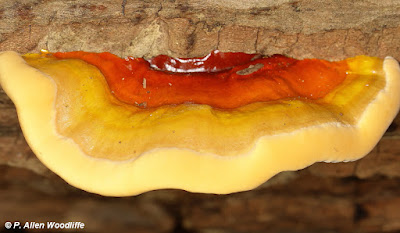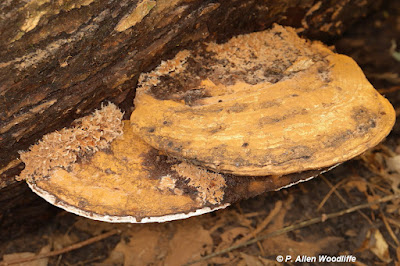Fall is a great time to find fungi, especially when it has been warm and wet like it was over the last few weeks. I have been out at various wooded areas specifically to find and photograph fungi, with a fair bit of success. I also wanted to put my newest Canon camera, the R6 mirrorless body, to work using its impressive sensor along with the tilt viewing screen which enabled me to get ground level photographs without having to lie on the ground to see through the view finder.
 |
| A type of Honey Mushroom |
Another useful source of information is this link.
Identification to the species level is not easy. Some may be identified by their macro characters, such as the morels, but many are only identified for certain through an analysis of their spore prints or through dissection. Therefore many of the ones I feature on this post are not identified to species, and some of those that are, are my best guess based on the reference sources I have, or via iNaturalist. Even iNaturalist will only give a general indication of what species it is, since identification based on a single photo is not nearly the same as spore prints and/or dissection, especially since the above ground parts of the fungi are quite short-lived and change considerably. Some may only be visible in good condition for a few hours or days, and disappear once their purpose of dispersing spores has been completed.
Fungi aren't everyone's favourite elements of nature, I get that. But the world would be a much different place if it weren't for the million and a half or so species of fungi that are known across the world. They are at work underground, on leaves, as well as in dead or living wood. Some are the wood-decaying fungi, such as those bracket fungi you see growing on dead or living trees.
There are others that grow from the ground, and are key to providing moisture, nourishment and protection to the tree roots in exchange for some sugars they get from the tree's photosynthetic activity. In fact a mature living tree will have hundreds of thousands of kilometres of hyphae, or mycorrhizae, wrapped around the roots. Those fungal threads in reality make up the bulk of each individual fungus. That is why fungi are critical to a healthy forest, and even when plantations are attempted in agricultural lands, do not do well since the mycorrhizae in the soil have been destroyed through repeated disturbance from tilling and chemical application. The part of the fungus we see above ground is only the fruiting body of the fungus whose sole purpose is to disperse thousands of tiny spores from the gills or pores, to continue the process.
They can be valuable as a source of food for creatures of the forest, including rodents, but also for invertebrates such as this slug, which may in turn be a source of food for something else. Of course we know that some fungi are sought out to be eaten by humans as well, even though many are not edible.
With that, I will feature some of my most favourite photos that I have taken over the past week or so. All were taken at either Rondeau or Clear Creek Forest provincial parks, or at the municipally-owned McKerrall Woods.
Some are quite distinctive, such as this Bear Head's Tooth, shown first....
This next one is the White Jelly Fungus.
Sometimes one encounters just a glob, which is probably the Abortive Entoloma. It is a fungus which is parasitic on other fungi, typically on one of the Honey Mushrooms (Armillaria spp.)
Bracket fungi are fairly common. Some have gills such as the first couple show.
 |
| Common Fibre Vase |
Some are quite colourful, especially members of the Ganoderma genus, which often show a shiny lacquered surface.
One of the more common bracket fungus types is the Turkey Tail, which has quite a variety of patterns.
Others have tubes instead of gills, such as these, from which the spores are released.
Occasionally you may find a fungus with another other fungus growing on it, as these next two photos show, with the second photo showing a close-up of a fungus growing on the other. I have seen this occurrence on occasion, but haven't got many photos to show.
Some are quite colourful. One of my favourites to find and photograph is this next one, the Orange Mycena.
 |
| Scarlet Waxy Cup |
There are numerous small, less colourful ones, which are attractive in their own way. The first two are probably members of the Honey Mushroom group, sometimes called Bonnets.
One you may find on lawns is the Fairy Ring Mushroom. This was in the picnic area of Rondeau, and it commonly occurs in a ring, appearing fairly quickly overnight, hence the reference to a fairy visiting and creating this arrangement.
This is a close-up of one of the mushrooms in the fairy ring.
This next one is possibly called Angel's Wings.
And some are very small, spreading across the cut surface of a log.
There are quite a few in the slime mould group. The one below is a type of Stemonitis, also known as a Chocolate Tube Slime. It has numerous feathery strands that disperse powdery spores with the slightest breeze.
A fungus that may be better known to some readers is the Giant Puffball. When it is fresh and edible it is almost pure white, with an interior that is solid white. But it doesn't remain in that condition for long, as its prime purpose is to disperse spores, so it quickly deteriorates by turning a yellowish brown, and as the outer layer is damaged or falls apart, releases thousands and thousands of spores.
Much smaller puffball types are this Pear-shaped Puffball.
Some mushrooms are deadly poisonous. Some of the most deadly are the Amanita group, which may have a colourful scaly cap. I don't have any recent photos of them, but I did come across this Golden Pholiota on one of my outings, which has a scaly cap as well. It apparently is edible.
The world of fungi is definitely fun to explore, and there are so many great photo ops!If you want to subscribe, or unsubscribe, to Nature Nuggets, send an email to prairietramper@gmail.com


































Awesome Allen!
ReplyDeleteThanks, Deb!
DeleteReally enjoyed the variety of fungi you found. And great photos!
ReplyDeleteThanks, Furry. I'm glad you enjoyed the variety. Fungi are a great subject to search for and photograph, and they don't move around :-).
DeleteWhat a fabulous post! More please?
ReplyDeleteThank-you Paula. More will be on their way soon!
Delete